Overview
- Brief Narrative
- Color lithographic print of a traditional Rosh Hashanah liturgy created by Arthur Szyk in New Canaan, Connecticut. The image was originally printed in the book, Six paintings of Jewish holidays, in 1948. The print depicts the reading of the Mahzor (the prayer book for the high holidays) during a morning service inside of a synagogue with a congregation member preparing to blow a shofar (a hollow animal horn used as a musical horn), a symbolic act that only occurs during Rosh Hashanah. Rosh Hashanah celebrates the Jewish new year and is a time for celebration and introspection. Born to Jewish parents in Łódź, Poland, Szyk studied and worked on projects throughout Europe, drawing on his personal experiences when creating images. When Szyk returned to Poland, he served in the Russian Army during World War I. While serving, he became an artistic director for the Polish Department of Propaganda during the Polish–Soviet War. In 1937, Szyk moved to England to escape the increasing antisemitism and rising Nazi threat. When Germany invaded Poland in 1939, Szyk began contributing illustrations and caricatures of Hitler and the Nazis to the war propaganda campaign. In 1940, he was able to immigrate to the United States, where he continued his career as an illustrator and contributed anti-Nazi cartoons to publications such as Life, Time, and Esquire. His widely published caricatures made him one of the most famous political satirists during World War II and he was considered one of the greatest modern practitioners of the art of illumination.
- Title
- Rosh Hashanah
- Series Title
- Holiday Series
- Date
-
publication/distribution:
1948
- Geography
-
creation:
New Canaan (Conn.)
- Credit Line
- United States Holocaust Memorial Museum Collection, Gift of the Estate of Robert Levitt
- Markings
- front, below image, printed, black and red ink : Rosh Hashanah
front, bottom, printed, black ink : © FD USA - Signature
- front, bottom left, printed, black ink : ARTHUR SZYK. NEW CANAAN, 48.
- Contributor
-
Artist:
Arthur Szyk
Subject: Arthur Szyk
- Biography
-
Arthur Szyk (1894-1951) was born to Jewish parents, Solomon and Eugenia Szyk in Łódź, Poland, which at the time was part of the Russian Empire. He had his first public art exhibition at age 15, and then went to Paris, France, for formal art training at the Academie Julian. He visited Palestine in 1914 with a group of Polish-Jewish artists and studied Muslim art. Upon his return, he was conscripted into the Russian Army and served in World War I. He married Julia Liekerman in 1916, and they had a son, George, in 1917. In 1918, Poland regained independence, but continued to fight a series of regional wars to secure its boundaries. Between 1919 and 1920, during Poland's war against the Soviet Bolsheviks, Syzk served as a cavalry officer and artistic director of the Department of Propaganda for the Polish Army in Łódź. In 1921, he and his family moved to Paris where his daughter, Alexandra was born the following year.
Szyk was well known for his illuminations and book illustrations, in a style reminiscent of Persian miniatures. He worked on several significant projects in France, including illustrating the Statute of Kalisz, the Haggadah, and a series of watercolors on the American Revolutionary War. The themes of his most admired works, democracy and Judaism, were already well established, earning him both fame and significant commissions. In 1934, Szyk traveled to the United States for exhibitions of his work and to receive the George Washington Bicentennial Medal, awarded by the US Congress. He resided in England from 1937-1940 to supervise the publication of the Haggadah. In 1939, following Germany's invasion of Poland, he focused on producing anti-Nazi editorial cartoons published in many Western newspapers and magazines. During the German occupation of Poland, his 70 year old mother, Eugenia, and her Polish companion were forced to live in the Łódź ghetto. In 1943, they were transported to Majdanek concentration camp and killed.
In late 1940, Szyk immigrated to the United States with his family. He became a leading anti-Fascist political caricaturist as well as an advocate for Jewish rescue. In addition to his widely published satirical art, Szyk devoted a great deal of time and energy to the Emergency Committee to Save the Jewish People of Europe, and pushed for the establishment of an independent Jewish state in Palestine. Szyk received his US citizenship in 1948. In 1951, he was investigated by the United States House Un-American Activities Committee as a suspected Communist. His son, speaking on his behalf, declared his non-affiliation with any Communist organization. Later that year, on September 13, Szyk suffered a heart attack and died at age 57.
Physical Details
- Language
- English
- Classification
-
Art
- Category
-
Prints
- Object Type
-
Prints (lcsh)
- Genre/Form
- Prints.
- Physical Description
- Color lithographic print adhered to rectangular, discolored, off-white, heavyweight paper. The large center image depicts a congregation in a synagogue worshipping during Rosh Hashanah. All the men and boys wear either black kippahs or brown shtreimels and they all have white and black striped tallits over their shoulders. The older men have long, white beards, the younger men have short beards, and the children have payot side locks. In the center of the image is a large, golden bimah draped with a green and gold-colored cloth that is decorated with flowers, a crown, and a large Star of David. Laying on the bimah platform is an open Torah scroll flanked by two large silver candle holders, each holding a large white candle. On top of the bimah sits a large, gold menorah, with an open scroll behind it. Behind the bimah are two older men, one is blowing a shofar, and the other is reading the machzor, as is the rest of the congregation. Seated in the back, are the rest of the males of the congregation. The women are seated above in a gold-guilded balcony. The walls are green and blue and there is a gold-colored chandelier hanging from the ceiling. The back is discolored around the edges and has several smudges and small stains.
- Dimensions
- overall: Height: 8.500 inches (21.59 cm) | Width: 10.000 inches (25.4 cm)
- Materials
- overall : paper, ink, adhesive
Rights & Restrictions
- Conditions on Access
- No restrictions on access
- Conditions on Use
- Restrictions on use. Copyright retained by the estate of Arthur Szyk.
Keywords & Subjects
- Topical Term
- Emigration and immigration--Poland. Jewish art and symbolism--Poland--Pictorial works. Jewish artists--United States. Jews in art. Jews--Social life and customs. Judaism--Customs and practices. Lithography. Rosh ha-Shanah--Customs and practices. Rosh ha-Shanah Liturgy. Rosh ha-Shanah sermons.
- Geographic Name
- New Canaan (Conn.) Łódź (Poland)
- Personal Name
- Szyk, Arthur, 1894-1951.
Administrative Notes
- Legal Status
- Permanent Collection
- Provenance
- The print was donated to the United States Holocaust Memorial Museum in 2018 by Susan Stamberg, the daughter of Robert Levitt.
- Record last modified:
- 2023-02-24 10:10:03
- This page:
- https://collections.ushmm.org/search/catalog/irn625530
Download & Licensing
In-Person Research
- By Appointment
- Request 21 Days in Advance of Visit
- Plan a Research Visit
- Request to See This Object
Contact Us
Also in Robert Levitt collection
The collection consists of seven prints of Arthur Syzk paintings that relate to his experiences in Poland and the United States before, during, and after the Holocaust.
Date: 1945-1948
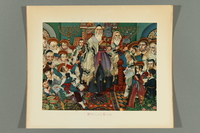
Print of an Arthur Szyk painting depicting the Simchat Torah celebration
Object
Color lithographic print of the Simchat Torah celebration, created by Arthur Szyk in New Canaan, Connecticut. The image was originally printed in the book, Six paintings of Jewish holidays, in 1948. The print depicts the male members of a Jewish congregation traditionally celebrating the religious holiday, Simchat Torah (Rejoicing with the Torah) by carrying the Torah scrolls (handwritten copy of the Torah, the five books of Moses) around the bimah (podium where the Torah and Prophets are read) and the synagogue while singing, dancing, and reciting chants. The Simchat Torah marks and celebrates completion of the annual Torah readings. Born to Jewish parents in Łódź, Poland, Szyk studied and worked on projects throughout Europe, drawing on his personal experiences when creating images. When Szyk returned to Poland, he served in the Russian Army during World War I. While serving, he became an artistic director for the Polish Department of Propaganda during the Polish–Soviet War. In 1937, Szyk moved to England to escape the increasing antisemitism and rising Nazi threat. When Germany invaded Poland in 1939, Szyk began contributing illustrations and caricatures of Hitler and the Nazis to the war propaganda campaign. In 1940, he was able to immigrate to the United States, where he continued his career as an illustrator and contributed anti-Nazi cartoons to publications such as Life, Time, and Esquire. His widely published caricatures made him one of the most famous political satirists during World War II and he was considered one of the greatest modern practitioners of the art of illumination.
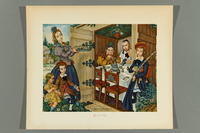
Print of an Arthur Szyk painting depicting a family eating a meal for Sukkot
Object
Color lithographic print of a traditional Succoth meal created by Arthur Szyk in New Canaan, Connecticut. The image was originally printed in the book, Six paintings of Jewish holidays, in 1948. The print depicts a family sitting down to eat in a sukkah (temporary hut with a thatched roof that represents the huts the Israelites dwelt in after leaving Egypt), and gathering palm, myrtle, willow (lulav), and citron (etrog), which is traditionally held and shaken. The Sukkot holiday celebrates the gathering of the harvest and commemorates the protection God provided for the children of Israel when they left Egypt. Born to Jewish parents in Łódź, Poland, Szyk studied and worked on projects throughout Europe, drawing on his personal experiences when creating images. When Szyk returned to Poland, he served in the Russian Army during World War I. While serving, he became an artistic director for the Polish Department of Propaganda during the Polish–Soviet War. In 1937, Szyk moved to England to escape the increasing antisemitism and rising Nazi threat. When Germany invaded Poland in 1939, Szyk began contributing illustrations and caricatures of Hitler and the Nazis to the war propaganda campaign. In 1940, he was able to immigrate to the United States, where he continued his career as an illustrator and contributed anti-Nazi cartoons to publications such as Life, Time, and Esquire. His widely published caricatures made him one of the most famous political satirists during World War II and he was considered one of the greatest modern practitioners of the art of illumination.
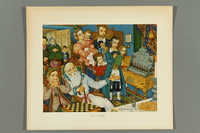
Print of an Arthur Szyk painting depicting Hanukkah festivities
Object
Color lithographic print of a traditional communal Hanukkah celebration created by Arthur Szyk in New Canaan, Connecticut. The image was originally printed in the book, Six paintings of Jewish holidays, in 1948. The print depicts several members of a community gathering to celebrate Hanukkah by lighting a Hanukkiah (a candelabrum that holds eight candles for the eight nights of Hanukkah, plus the Shamash [attendant] that is used to light the other candles), playing games, serving Latkes, and singing Hanukkah songs. Hanukkah celebrates the rededication of the Temple in Jerusalem during the Jewish revolt against the oppressive Seleucid Empire. Born to Jewish parents in Łódź, Poland, Szyk studied and worked on projects throughout Europe, drawing on his personal experiences when creating images. When Szyk returned to Poland, he served in the Russian Army during World War I. While serving, he became an artistic director for the Polish Department of Propaganda during the Polish–Soviet War. In 1937, Szyk moved to England to escape the increasing antisemitism and rising Nazi threat. When Germany invaded Poland in 1939, Szyk began contributing illustrations and caricatures of Hitler and the Nazis to the war propaganda campaign. In 1940, he was able to immigrate to the United States, where he continued his career as an illustrator and contributed anti-Nazi cartoons to publications such as Life, Time, and Esquire. His widely published caricatures made him one of the most famous political satirists during World War II and he was considered one of the greatest modern practitioners of the art of illumination.
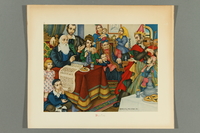
Print of an Arthur Szyk painting depicting an extended family celebrating Purim
Object
Color lithographic print of a communal Purim celebration created by Arthur Szyk in New Canaan, Connecticut. The image was originally printed in the book, Six paintings of Jewish holidays, in 1948. The print depicts the reading of the Scroll of Esther (the Megillah) and a man and boy celebrating in costume. Purim celebrates Esther, a Queen of Persia, saving of the Jewish people from a massacre planned by an advisor to the King. The holiday is traditionally celebrated with wild abandon and with the giving of gifts to friends and the poor. Born to Jewish parents in Łódź, Poland, Szyk studied and worked on projects throughout Europe, drawing on his personal experiences when creating images. When Szyk returned to Poland, he served in the Russian Army during World War I. While serving, he became an artistic director for the Polish Department of Propaganda during the Polish–Soviet War. In 1937, Szyk moved to England to escape the increasing antisemitism and rising Nazi threat. When Germany invaded Poland in 1939, Szyk began contributing illustrations and caricatures of Hitler and the Nazis to the war propaganda campaign. In 1940, he was able to immigrate to the United States, where he continued his career as an illustrator and contributed anti-Nazi cartoons to publications such as Life, Time, and Esquire. His widely published caricatures made him one of the most famous political satirists during World War II and he was considered one of the greatest modern practitioners of the art of illumination.
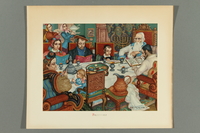
Print of an Arthur Szyk painting depicting a family eating diner during Passover
Object
Color lithographic print of a Passover Seder (ritual meal) created by Arthur Szyk in New Canaan, Connecticut. The image was originally printed in the book, Six paintings of Jewish holidays, in 1948. The print depicts an extended family seated at a table reading the Book of Exodus and waiting for food to be served. Passover commemorates the Exodus of the Jewish people from Egypt and celebrates God as the liberator of humanity. The name comes from the miracle in which God “passed over” the houses of the Israelites during the tenth plague. Born to Jewish parents in Łódź, Poland, Szyk studied and worked on projects throughout Europe, drawing on his personal experiences when creating images. When Szyk returned to Poland, he served in the Russian Army during World War I. While serving, he became an artistic director for the Polish Department of Propaganda during the Polish–Soviet War. In 1937, Szyk moved to England to escape the increasing antisemitism and rising Nazi threat. When Germany invaded Poland in 1939, Szyk began contributing illustrations and caricatures of Hitler and the Nazis to the war propaganda campaign. In 1940, he was able to immigrate to the United States, where he continued his career as an illustrator and contributed anti-Nazi cartoons to publications such as Life, Time, and Esquire. His widely published caricatures made him one of the most famous political satirists during World War II and he was considered one of the greatest modern practitioners of the art of illumination.
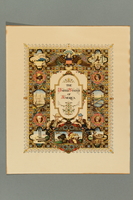
Print of an Arthur Szyk painting featuring iconic images of Americana
Object
Color lithographic print from the United Nations Series, originally painted by Arthur Szyk in New Canaan, Connecticut. Each image in the series was to be a highly detailed single-page piece that combined symbols, scenes, portraits, and decorative motifs to create a visual history of each member country of the United Nations. The series was commissioned by Kasimir Bileski, and the images were meant to be cover pages for an international stamp book. Szyk was to continue painting these histories as new countries joined the United Nations, but he only completed nine before his death in 1951. Born to Jewish parents in Łódź, Poland, Szyk studied and worked on projects throughout Europe, drawing on his personal experiences when creating images. When Szyk returned to Poland, he served in the Russian Army during World War I. While serving, he became an artistic director for the Polish Department of Propaganda during the Polish–Soviet War. In 1937, Szyk moved to England to escape the increasing antisemitism and rising Nazi threat. When Germany invaded Poland in 1939, Szyk began contributing illustrations and caricatures of Hitler and the Nazis to the war propaganda campaign. In 1940, he was able to immigrate to the United States, where he continued his career as an illustrator and contributed anti-Nazi cartoons to publications such as Life, Time, and Esquire. His widely published caricatures made him one of the most famous political satirists during World War II and he was considered one of the greatest modern practitioners of the art of illumination.



